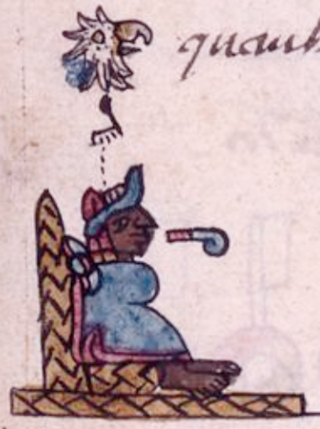
Cuauhtémoc, also known as Cuauhtemotzín, Guatimozín, or Guatémoc, was the Aztec ruler (tlatoani) of Tenochtitlan from 1520 to 1521, making him the last Aztec Emperor. The name Cuauhtemōc means "one who has descended like an eagle", and is commonly rendered in English as "Descending Eagle", as in the moment when an eagle folds its wings and plummets down to strike its prey. This is a name that implies aggressiveness and determination.

The Aztecs were a Mesoamerican culture that flourished in central Mexico in the post-classic period from 1300 to 1521. The Aztec people included different ethnic groups of central Mexico, particularly those groups who spoke the Nahuatl language and who dominated large parts of Mesoamerica from the 14th to the 16th centuries. Aztec culture was organized into city-states (altepetl), some of which joined to form alliances, political confederations, or empires. The Aztec Empire was a confederation of three city-states established in 1427: Tenochtitlan, city-state of the Mexica or Tenochca, Texcoco, and Tlacopan, previously part of the Tepanec empire, whose dominant power was Azcapotzalco. Although the term Aztecs is often narrowly restricted to the Mexica of Tenochtitlan, it is also broadly used to refer to Nahua polities or peoples of central Mexico in the prehispanic era, as well as the Spanish colonial era (1521–1821). The definitions of Aztec and Aztecs have long been the topic of scholarly discussion ever since German scientist Alexander von Humboldt established its common usage in the early 19th century.

In Aztec mythology, Tonacatecuhtli was a creator and fertility god, worshipped for populating the earth and making it fruitful. Most Colonial-era manuscripts equate him with Ōmetēcuhtli. His consort was Tonacacihuatl.
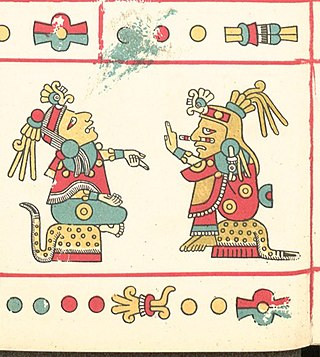
Ōmeteōtl is a name used to refer to the pair of Aztec deities Ometecuhtli and Omecihuatl, also known as Tōnacātēcuhtli and Tonacacihuatl. Ōme translates as "two" or "dual" in Nahuatl and teōtl translates as "god". The existence of such a concept and its significance is a matter of dispute among scholars of Mesoamerican religion. Ometeotl was one as the first divinity, and Ometecuhtli and Omecihuatl when the being became two to be able to reproduce all creation.
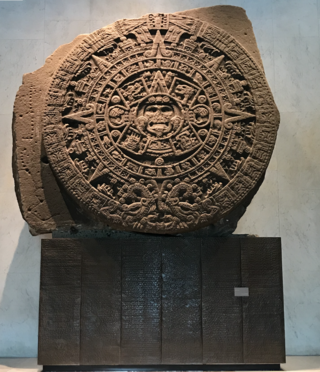
The Aztec or Mexica calendar is the calendrical system used by the Aztecs as well as other Pre-Columbian peoples of central Mexico. It is one of the Mesoamerican calendars, sharing the basic structure of calendars from throughout the region.
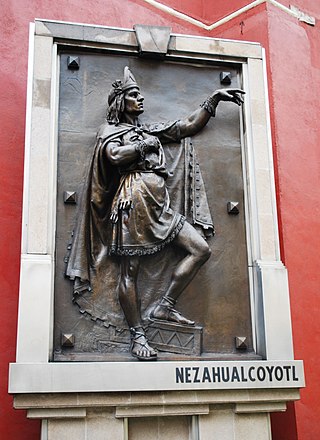
Nezahualcoyotl was a scholar, philosopher (tlamatini), warrior, architect, poet and ruler (tlatoani) of the city-state of Texcoco in pre-Columbian era Mexico. Unlike other high-profile Mexican figures from the century preceding Spanish conquest of the Aztec Empire, Nezahualcoyotl was not fully Mexica; his father's people were the Acolhua, another Nahuan people settled in the eastern part of the Valley of Mexico, on the coast of Lake Texcoco. His mother, however, was the sister of Chimalpopoca, the Mexica king of Tenochtitlan.
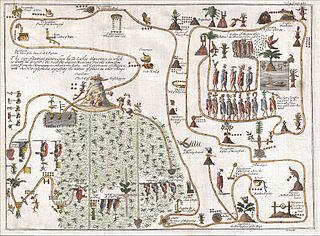
“Aztlán” is the ancestral home of the Aztec peoples. Astekah is the Nahuatl word for "people from Aztlan". Aztlan is mentioned in several ethnohistorical sources dating from the colonial period, and while they each cite varying lists of the different tribal groups who participated in the migration from Aztlan to central Mexico, the Mexica who went on to found Mexico-Tenochtitlan are mentioned in all of the accounts.

The Nahuas are a group of the indigenous people of Mexico, El Salvador, Guatemala, Honduras, Nicaragua, and Costa Rica. They comprise the largest indigenous group in Mexico and second largest in El Salvador. They are a Mesoamerican ethnicity. The Mexica (Aztecs) were of Nahua ethnicity, and the Toltecs are often thought to have been as well, though in the pre-Columbian period Nahuas were subdivided into many groups that did not necessarily share a common identity.

Pozole is a traditional soup or stew from Mexican cuisine. It is made from hominy with meat, and can be seasoned and garnished with shredded lettuce or cabbage, chilli peppers, onion, garlic, radishes, avocado, salsa or limes. Known in Mesoamerica since the pre-Columbian era, the stew is common across Mexico and neighboring countries, served both as a day-to-day meal and as a festive dish.
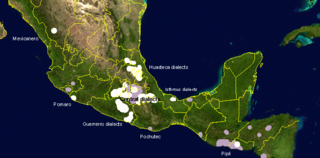
The Nahuan or Aztecan languages are those languages of the Uto-Aztecan language family that have undergone a sound change, known as Whorf's law, that changed an original *t to before *a. Subsequently, some Nahuan languages have changed this to or back to, but it can still be seen that the language went through a stage. The best known Nahuan language is Nahuatl. Nahuatl is spoken by about 1.7 million Nahua peoples.
Classical Nahuatl is any of the variants of Nahuatl spoken in the Valley of Mexico and central Mexico as a lingua franca at the time of the 16th-century Spanish conquest of the Aztec Empire. During the subsequent centuries, it was largely displaced by Spanish and evolved into some of the modern Nahuan languages in use today. Although classified as an extinct language, Classical Nahuatl has survived through a multitude of written sources transcribed by Nahua peoples and Spaniards in the Latin script.
The Anales de Tlatelolco is a codex manuscript written in Nahuatl, using Latin characters, by anonymous Aztec authors. The text has no pictorial content. Although there is an assertion that the text was a copy of one written in 1528 in Tlatelolco, only seven years after the fall of the Aztec Empire, James Lockhart argues that there is no evidence for this early date of composition, based on internal evidence of the text. However, he supports the contention that this is an authentic conquest account, arguing that it was composed about 20 years after the conquest in the 1540s, and contemporaneous with the Cuernavaca censuses. Unlike the Florentine Codex and its account of the conquest of the Aztec Empire, the Annals of Tlatelolco remained in Nahua hands, providing authentic insight into the thoughts and outlook of the newly conquered Nahuas.
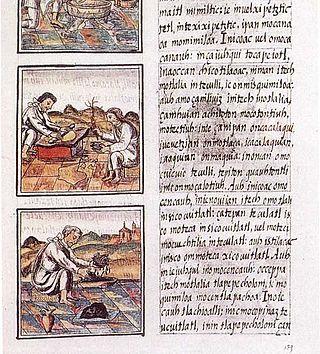
The Florentine Codex is a 16th-century ethnographic research study in Mesoamerica by the Spanish Franciscan friar Bernardino de Sahagún. Sahagún originally titled it: La Historia General de las Cosas de Nueva España. After a translation mistake, it was given the name Historia general de las Cosas de Nueva España. The best-preserved manuscript is commonly referred to as the Florentine Codex, as the codex is held in the Laurentian Library of Florence, Italy.
Teōtl is a Nahuatl term for sacredness or divinity that is sometimes translated as "god". For the Aztecs teotl was the metaphysical omnipresence upon which their religious philosophy was based.
The Aztec or Nahuatl script is a pre-Columbian writing system that combines ideographic writing with Nahuatl specific phonetic logograms and syllabic signs which was used in central Mexico by the Nahua people.
Orizaba Nahuatl is a native American language spoken in the southeastern Mexican state of Veracruz mostly in the area to the south of the city of Orizaba. It is also known as Orizaba Aztec and Náhuatl de la Sierra de Zongolica. It has 79 percent intelligibility with Morelos Nahuatl. There is a dialect called Ixhuatlancillo Nahuatl which is spoken in a town to the north of Orizaba. There is one secondary school which uses this language.

The Mexica were a Nahuatl-speaking people of the Valley of Mexico who were the rulers of the Mexica Empire. The Mexica established Tenochtitlan, a settlement on an island in Lake Texcoco, in 1325. A dissident group in Tenochtitlan separated and founded the settlement of Tlatelolco with its own dynastic lineage. In 1521, they were conquered by an alliance of Spanish conquistadors and indigenous people including the Tlaxcaltecs led by Hernán Cortés.
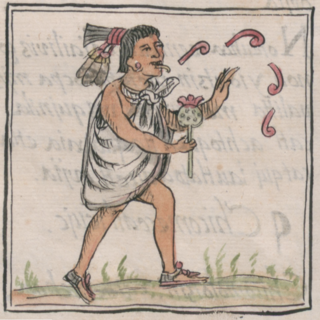
Nahuatl, Aztec, or Mexicano is a language or, by some definitions, a group of languages of the Uto-Aztecan language family. Varieties of Nahuatl are spoken by about 1.7 million Nahua peoples, most of whom live mainly in Central Mexico and have smaller populations in the United States.
Coatepec Nahuatl is a variety of Nahuatl of southwestern Mexico State and Guerrero spoken by 1,400 people.
The Guerrero Nahuatl language is a Nahuan language spoken by about 125,000 people in Mexico.












